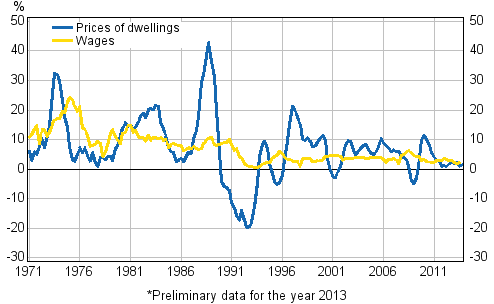3. Changes in prices of dwellings and in earnings level
The price development of dwellings has varied much within the last 40 years or so. During the overheating of the housing market, prices rose by over 40 per cent in the last quarter of 1988 compared with the previous year. Correspondingly, during the recession of the early 1990s, prices of dwellings fell by as much as 20 per cent from the year before. From 1996 dwelling prices rose up to the middle of the year 2008, with the exception of the year 2001. The outbreak of the international financial crisis in autumn 2008 slowed down the housing market and prices fell by five per cent from the third quarter of 2008 until the first quarter of 2009. From the middle of 2009 onwards, prices of dwellings have continued to grow again. The rise in dwelling prices has clearly slowed down from year 2011.
Over the same time period changes in wages and salaries have been more moderate than changes on the housing market, except for the mid-1970s, when the earnings level rose by over 20 per cent per year due to the great inflation. Over the 2000s wages and salaries have gone up yearly by an average of four per cent. The average annual rise in prices of dwellings has been one percentage point faster, which has undermined the purchasing power of wages and salaries on the housing markets.
Figure 3. Year-on-year changes in prices of dwellings and in wages and salaries 1971–2013, 4th quarter*

Source: Prices of dwellings in housing companies. Statistics Finland
Inquiries: Petri Kettunen 09 1734 3558, Tomi Martikainen 09 1734 3632, asuminen@stat.fi
Director in charge: Leena Storg�rds
Updated 28.1.2014
Official Statistics of Finland (OSF):
Prices of dwellings in housing companies [e-publication].
ISSN=2323-8801. December 2013,
3. Changes in prices of dwellings and in earnings level
. Helsinki: Statistics Finland [referred: 22.12.2025].
Access method: http://stat.fi/til/ashi/2013/12/ashi_2013_12_2014-01-28_kat_003_en.html

